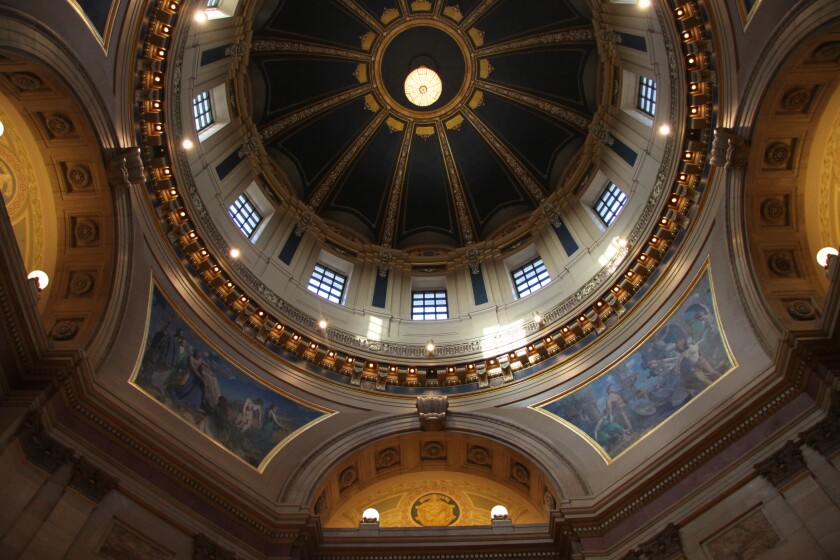ST. PAUL — With just under two weeks left of the regular legislative session, the clock is ticking for Minnesota lawmakers to pull their budget together.
This year, a big part of that process is creating new taxes to ensure ongoing revenue streams for expanded spending backed by Democratic-Farmer Labor lawmakers and Gov. Tim Walz, who say they want to make Minnesota an attractive state for working families through programs like paid family leave and child tax credits.
ADVERTISEMENT
To do that they’re pulling together an approximately $70 billion budget for the next two years — a significant increase over the previous more than $50 billion budget for the same period. But with a historic $17.5 billion surplus Republicans and other critics say the state should focus on broad tax relief.
DFLers say they have to come up with new ongoing revenue streams to pay for growing government costs and to support their new programs. About $12 billion of the surplus is one-time money, and the general framework the DFL and the governor reached on the budget calls for about $18 billion in extra spending.
To cover those costs, they’re proposing billions in new taxes in several bills — though House and Senate DFL tax proposals also include $3 billion-$4 billion in tax cuts in the form of rebates, credits and other programs for people in the state they say need it most. That includes eliminating Social Security income tax for more than 70% of Minnesotans and direct rebate checks of about $275 for single filers earning up to $75,000.
While both the House and Senate have passed bills including new taxes, there are some differences they’ll have to reconcile in joint committees. They must make the bills identical to one another and pass them again before May 22 so the governor can sign them into law.
Here are some of the bigger proposals:
Delivery tax
A 75-cent state fee on most retail deliveries is on the table as DFL lawmakers continue to debate taxes. The House version of the tax bill would include that fee on deliveries like food and Amazon shipments. Items like medication would be exempt.
It’s uncertain whether that tax will be part of the final bill. The Senate version of the bill does not include the added delivery fee, and it's the subject of negotiations in a conference committee. If enacted, it would bring in about $175 million a year starting in 2025.
ADVERTISEMENT
Walz said the state needs more money to fund transportation, but he didn’t want to weigh in specifically on the tax as lawmakers continue to debate the policy.
“I think I've made it clear that I wanted to see us have some ongoing revenues for transportation because the shortfall was well-known,” Walz said. “The one-time funding doesn't do it. We didn't propose that in our bill, but we're waiting to look and see what comes out.”
Last month, House Speaker Melissa Hortman said the delivery tax is an alternative to the unpopular option of raising gas taxes. Colorado recently enacted a delivery tax of 27 cents.
Paid family and medical leave
A new paid family and medical leave program that has now passed out of the Senate and the House will create a new 0.7% payroll tax for Minnesota businesses and employees. In total, the new program would create $1.5 billion or more a year in new taxes. Individuals would pay about $3 a week on average, according to past estimates from nonpartisan legislative research.
5th tier ‘millionaires tax’
Another tax still up for consideration is the creation of a new fifth-tier tax bracket for the highest-earning Minnesotans. The new tier dubbed the “millionaires’ tax” by House DFLers would create a 10.85% tax for individual filers making more than $600,000 a year and joint filers earning more than $1 million.
A fifth new tax tier would affect 24,200 tax returns in the state with an average increase of $9,231, according to the Department of Revenue. It would account for 0.8% of all returns. Revenue Department analysis predicts the new tier would bring Minnesota an additional $281 million in revenue in 2024.
ADVERTISEMENT
While the House passed a tax bill containing the new bracket, it’s not in the Senate version of the bill and it's unclear if it has support.
License tab fees
Transportation bills passed by both the House and Senate include increases to motor vehicle registration tax. The House version of the bill is expected to bring in more than $700 million in the next four years.
The current tax is $10 plus 1.25% of the base value for a passenger vehicle. House legislation calls for that to increase to 1.915% for vehicles purchased before November 2020, and 1.95% for vehicles purchased after then. Senate legislation calls for a slightly lower increase, 1.54%.
In 2022, the average price of a new vehicle was $48,000, according to auto valuation and research publication Kelley Blue Book. The House version of the legislation would increase the average registration of a new $48,000 vehicle from $610 to $946.
Vehicle registrations in Minnesota drop down each year for 10 years after the purchase until the fee is $35.
ADVERTISEMENT
Motor vehicle sales tax
Both the Senate and House transportation bills raise the vehicle sales tax from 6.5% to 6.875%. It’s expected to bring in more than $200 million in additional taxes in the next four years.
Twin Cities metro sales taxes
There are a few sales tax increases on the horizon for the seven-county Twin Cities metro area in bills moving through the Legislature.
One which appears headed toward enactment is a 0.25% sales tax expected to generate $190 million for housing projects each year. A housing bill both chambers agreed upon passed the House on Monday and after a Senate vote will head to the governor’s desk.
A 0.75% sales tax to pay for transportation is still the subject of negotiations. The Senate version calls for a 0.5% increase. The 0.75% tax could bring in about $500 million a year starting in 2025, according to Department of Revenue analysis.
Worldwide reporting requirement
Both the Senate and House DFL tax plans included a new offshore income reporting requirement for corporations, something lawmakers said could bring in more than $1 billion over the next two years. Companies doing business in Minnesota would be subject to state tax on international income.
But at a hearing of a joint House-Senate tax committee last week, lawmakers dropped the proposal. But as the House and Senate continue to work on differences between the bills, there’s a chance a new capital gains tax originally proposed by the governor could be included to close the gap left by DFL lawmakers’ dropping of the offshore reporting requirement.
Follow Alex Derosier on Twitter or email aderosier@forumcomm.com .
ADVERTISEMENT

























